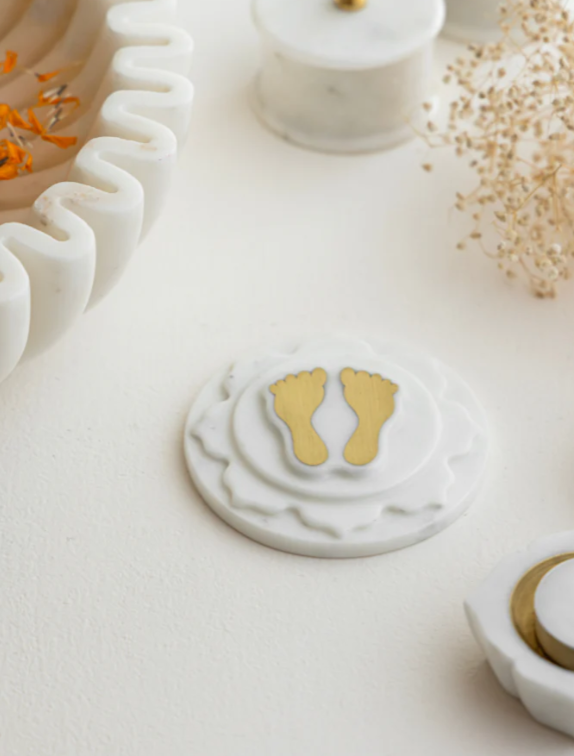How to Choose the Perfect Marble Laxmi Footprints for Your Pooja Room

When setting up a Pooja room, every element you choose plays an important role in creating a divine and spiritual atmosphere. Among all the traditional items, Marble Laxmi Footprints hold a very special place. Considered symbols of Goddess Lakshmi’s presence, these footprints are believed to invite prosperity, peace, and good fortune into the home. Choosing the perfect pair is not only about aesthetics but also about understanding tradition, material quality, and placement.
The Significance of Marble Laxmi Footprints in Pooja Rooms
In Hindu traditions, Goddess Lakshmi is the goddess of wealth and prosperity. Placing her sacred footprints in the Pooja room or at the entrance symbolizes her divine arrival into the household. Many families use Marble Laxmi Footprints during Diwali, festive rituals, or daily prayers as a way of inviting blessings into their lives. They are also placed in front of idols, near Kalash, or on temple steps to mark the presence of the goddess. Since marble itself is considered a pure and auspicious stone, it enhances the spiritual value of these sacred symbols.
Types of Marble Laxmi Footprints Available
Before buying, it’s essential to know the different types available in the market. Some footprints are plain and minimal, while others are intricately carved with traditional designs. You will also find colorful options with meenakari work, kundan embellishments, or golden accents. When choosing Marble Laxmi Footprints, consider your Pooja room décor and the type of rituals you perform. If you prefer a simple and traditional look, plain white marble works best. On the other hand, if you want something festive and decorative, painted or embellished versions add charm.
How to Select the Right Size and Style
The size of the footprints depends on the space available in your Pooja room. Smaller footprints are ideal for compact temple setups, while larger ones make a statement in bigger Pooja spaces. The thickness of the marble also matters, as sturdier pieces last longer. While some devotees prefer pairs of feet carved on a rectangular or circular marble base, others opt for standalone footprints that can be placed freely. Always check the smoothness of the finishing to ensure they look elegant and refined.
Placement Tips for Maximum Auspiciousness
Placement of the footprints is just as important as their design. Traditionally, these are placed at the entrance of the Pooja room to symbolize Goddess Lakshmi’s arrival into your sacred space. Many people also place them facing inward, as if the goddess is walking into the home. You can also position them in front of the idol of Goddess Lakshmi, near the Kalash during rituals, or on decorative thalis during Diwali puja. Ensuring that the footprints are always clean and polished adds to their spiritual energy.
Choosing Authentic Marble for Durability
One of the most important aspects when purchasing is ensuring that the material is genuine. Pure marble has a natural shine, smooth texture, and long-lasting strength. Artificial materials may look similar but tend to fade or chip with time. Always buy from trusted sellers who specialize in Pooja décor items. Authentic marble ensures that your Marble Laxmi Footprints remain beautiful for years while retaining their spiritual purity.
Aesthetic Appeal and Craftsmanship
Apart from material, the craftsmanship of the footprints adds to their beauty. Hand-carved designs with traditional motifs like lotus patterns, peacocks, or floral borders elevate the overall look of your Pooja room. Skilled artisans put detailed effort into making each piece unique, and this artistry reflects in the aura of your sacred space. If your Pooja room has a contemporary setup, you can also explore minimalist designs with smooth edges and subtle detailing.
Colors and Finishing Options
Although white marble is the most popular, footprints are also available in different shades and finishes. Some pieces come with red or golden highlights, while others include stone inlays or meenakari art. For festive occasions, bright and colorful versions are highly sought after. For daily use, however, classic white footprints remain the best choice. Choosing a color and finish that blends seamlessly with your temple décor ensures harmony in design and energy.
Budget-Friendly to Premium Options
The price of footprints varies depending on size, quality, and craftsmanship. Simple designs in smaller sizes are usually budget-friendly, while larger, handcrafted, and embellished footprints are on the premium side. It’s always advisable to balance quality and affordability. Remember, these are not just decorative items but sacred symbols, so investing in good quality ensures durability and spiritual authenticity.
Maintenance and Care for Longevity
Marble is a durable material but requires proper care to maintain its beauty. Clean the footprints regularly with a soft dry cloth or mild soap water. Avoid using harsh chemicals that may damage the polish or detailing. Keeping them dust-free ensures they continue to radiate divine energy. During festivals, you can decorate them with kumkum, haldi, or flower petals, which further enhance their auspiciousness.
Final Thoughts
Choosing the perfect Marble Laxmi Footprints for your Pooja room involves balancing tradition, authenticity, and aesthetics. From selecting the right size and design to ensuring genuine marble quality, every detail matters in creating a sacred and welcoming space for Goddess Lakshmi. With the right choice, these footprints not only add charm to your temple décor but also bring spiritual positivity, prosperity, and peace to your home.
- AI
- Vitamins
- Health
- Admin/office jobs
- News
- Art
- Causes
- Crafts
- Dance
- Drinks
- Film
- Fitness
- Food
- Oyunlar
- Gardening
- Health
- Home
- Literature
- Music
- Networking
- Other
- Party
- Religion
- Shopping
- Sports
- Theater
- Wellness


